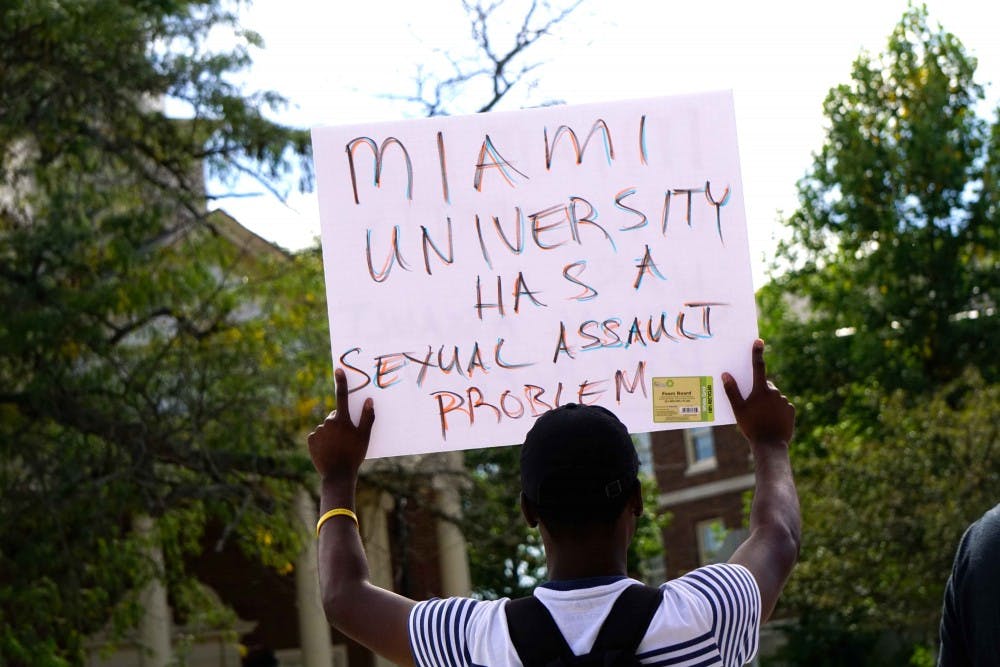[et_pb_section admin_label="section" bb_built="1"][et_pb_row admin_label="row"][et_pb_column type="4_4"][et_pb_text admin_label="Text" _builder_version="3.0.77" background_layout="light" border_style="solid" text_orientation="left" use_border_color="off" border_color="#ffffff"]
Last year, 25 people reported being sexually assaulted at Miami University -- the most to come forward since the university started releasing data on sexual assault in 2001. That figure is more than double the number of reports from 2015.
However, those figures don't represent the number of assaults which actually occurred in 2016. Reporting numbers are classified by the year in which an assault was reported, not when it happened.
Of last year's 25 reports, 11 incidents happened in 2016, and six occurred in 2015. The remaining assaults happened in previous years, with one report going as far back as 1987.
In the last three years, 2016 data shows the widest spread of dates in which reported assaults occurred. In 2014, all but one of the 14 total reported assaults occurred in that year, and seven of the 10 reported assaults in 2015 happened that year.
Miami President Gregory Crawford pointed to the 2016 jump in reports as a positive: more people are reporting.
"We want people to report," Crawford said. "It's a positive when more people are reporting and feeling comfortable with the process. When they report, we can then use our resources to help them."
Statistically, the majority of college students who are sexually assaulted are still not reporting it. The Rape, Abuse and Incest National Network (RAINN) estimates that only about 20 percent of college-age women who are sexually assaulted choose to report.
Nadia Dawisha, Miami alumna and co-administrator for the National Sexual Violence and Title IX Media Task Force, is an advocate for sexual assault survivors.
Delayed reporting of sexual assaults is very common, Dawisha said. Any sexual assault is a traumatic event.
"It's difficult to get out of bed in the morning, let alone file a report with the police," Dawisha said. "It's a very exhausting and grueling process."
It may take time, too, Dawisha said, for a survivor to even understand what happened, particularly if that person was using drugs or alcohol at the time of the assault.
Enjoy what you're reading?
Signup for our newsletter
Unreported assaults and delayed reporting of sexual assault, combined with the methods Miami and other universities use to record sexual assault reports, make deducing an accurate number of students who are sexually assaulted in a year an impossibility.
Under the Clery Act, data on campus crime, including sexual assault, is divided by where the reported offenses occurred. In 2016, of the 25 of the reported assaults, 12 happened in campus residence halls.
An additional six assaults were reported to have occurred on what is called "non-campus property," buildings and residences which are not located within Miami's campus but are owned and controlled by organizations affiliated with and recognized by the university. A fraternity house or any Miami study abroad location both fall under this category.
The figures which Miami is obligated to collect and release every year, mandated by the Clery Act, only include sexual assaults that happened on campus or in these "non-campus" locations.
When a Miami student is sexually assaulted in an apartment, off-campus house or other Uptown location, those reports are not included.
Lori Minges, Miami University's Clery Act coordinator, said numbers of sexual assaults off-campus are excluded from Clery data to allow for comparisons between colleges.
"The Clery Act has definitions to hopefully allow the consumer to look at each campus from an apple-to-apple comparison by having those geographic categories and certain definitions and rules," Minges said. "But every campus is unique and dynamic on its own."
In 2016, Oxford police recorded 20 sex offenses -- rape, sexual battery, sexual assault or sexual imposition -- but Oxford police do not designate on records when the victim of an assault is a Miami student, said Matt Stitzel, records specialist for Oxford Police.
Off-campus sexual assaults involving Miami students can be tracked, in part, through Campus Crime Alerts -- an SMS or email designed to alert students, faculty and staff of dangerous situations on or around campus.
Although these alerts notify students of some reports of sexual assaults, these notifications do not represent all of the sexual assaults which are reported. The decision to send out the alert is based on whether an incident poses an immediate threat to others students.
Information about some off-campus sexual assaults, including two last semester and one on Sept. 2 of this year, are not sent out through the Crime Alert system but are briefed on the university's myMiami homepage which is used by university students, faculty and staff.
Reports of sexual assault have been rising at other campuses, too. Clery data from the Ohio State University shows a jump from 25 reported incidents of rape in 2015 to 61 last year.
Ohio State accounts for that increase, in part, because of a new policy that includes sexual assault reports in its on-campus numbers when the exact location of the assault is unknown, but the possibility it occurred on campus cannot be ruled out. In 2016, that applied to 24 of the reported assaults.
Their administrators also point to the rise as a sign that efforts to encourage more reporting are working. According to their most recent Campus Climate survey, 77 percent of Ohio State students were somewhat or very knowledgeable about how to report sexual assault in 2017, compared to 48 percent in 2015.
Miami students who want to report a sexual assault can make their report to any campus security authority, including University Police (513-529-2222), Oxford Police (513-523-4321), the Office of Ethics and Student Conflict Resolution (513-529-1417), student organization advisors and athletic coaches.
Survivors can also seek receive confidential support from Nora McVey (513-431-1111), Miami's campus-based support specialist from the Butler County office of Women Helping Women.
@emilye_williams
[/et_pb_text][/et_pb_column][/et_pb_row][/et_pb_section]




